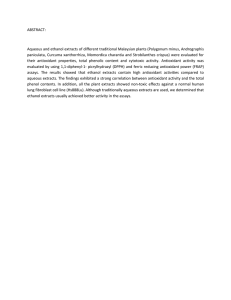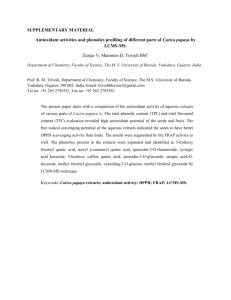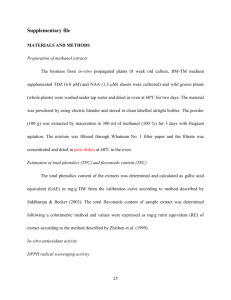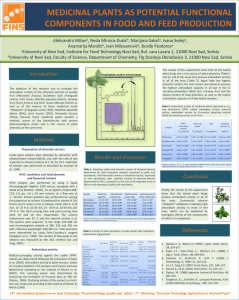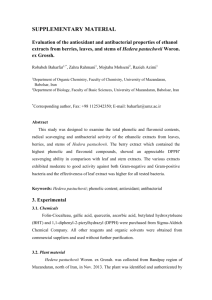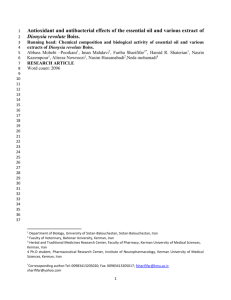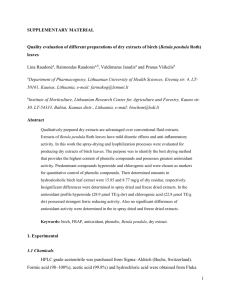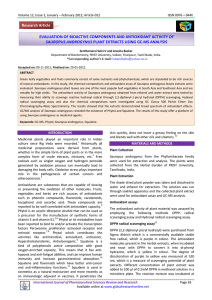SUPPLEMENTARY MATERIAL Egyptian herbal tea infusions
advertisement
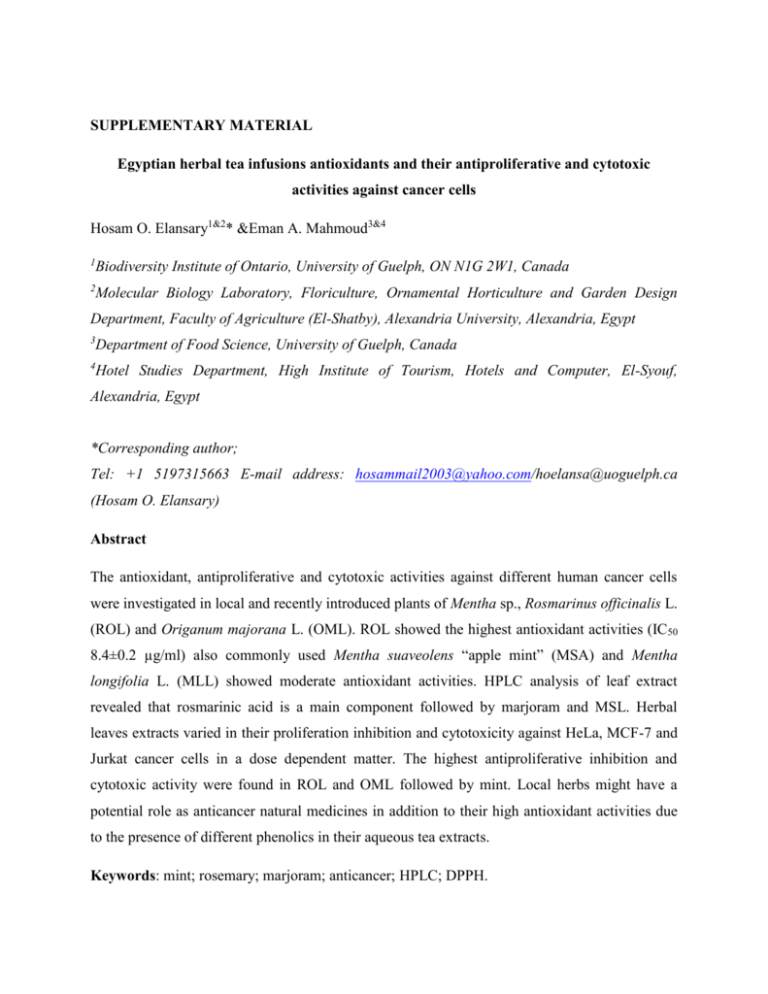
SUPPLEMENTARY MATERIAL Egyptian herbal tea infusions antioxidants and their antiproliferative and cytotoxic activities against cancer cells Hosam O. Elansary1&2* &Eman A. Mahmoud3&4 1 Biodiversity Institute of Ontario, University of Guelph, ON N1G 2W1, Canada 2 Molecular Biology Laboratory, Floriculture, Ornamental Horticulture and Garden Design Department, Faculty of Agriculture (El-Shatby), Alexandria University, Alexandria, Egypt 3 Department of Food Science, University of Guelph, Canada 4 Hotel Studies Department, High Institute of Tourism, Hotels and Computer, El-Syouf, Alexandria, Egypt *Corresponding author; Tel: +1 5197315663 E-mail address: hosammail2003@yahoo.com/hoelansa@uoguelph.ca (Hosam O. Elansary) Abstract The antioxidant, antiproliferative and cytotoxic activities against different human cancer cells were investigated in local and recently introduced plants of Mentha sp., Rosmarinus officinalis L. (ROL) and Origanum majorana L. (OML). ROL showed the highest antioxidant activities (IC50 8.4±0.2 µg/ml) also commonly used Mentha suaveolens “apple mint” (MSA) and Mentha longifolia L. (MLL) showed moderate antioxidant activities. HPLC analysis of leaf extract revealed that rosmarinic acid is a main component followed by marjoram and MSL. Herbal leaves extracts varied in their proliferation inhibition and cytotoxicity against HeLa, MCF-7 and Jurkat cancer cells in a dose dependent matter. The highest antiproliferative inhibition and cytotoxic activity were found in ROL and OML followed by mint. Local herbs might have a potential role as anticancer natural medicines in addition to their high antioxidant activities due to the presence of different phenolics in their aqueous tea extracts. Keywords: mint; rosemary; marjoram; anticancer; HPLC; DPPH. 1. Experimental 1.1. Plant material and preparation of the extracts Leaves samples were collected in August 2012 from grown plants of MLL, MSL, MPC, MSL, ROL and OML. The collecting site was located at Alexandria-Cairo desert road, Alexandria Egypt with 30.925579 latitude and 29.775524 longitudes. All ofMLL, MSL,MPCandMSA obtained vouchers at Egypt Barcode of Life project (www.egyptbol.org), faculty of Agriculture, Alexandria University (voucher No. Hosam00207-Hosam00210; respectively).Herbal extracts were obtained using either water or methanol according to the method of Pérez-Tortosa et al. (2012) with some modifications; 0.25 g of dried leaves were ground and dissolved in 3 ml methanol (99%) or hot water, then shaken on a magnetic agitator at minimal speed, in dark condition, for 1 h, at room temperature and centrifuged 5 min (4C) on 10000 RPM (7000xgr), then the supernatant was stored in sealed vials at -20ºC. 1.2. Chemicals Methanol, Tween 40, linoleic acid, β-carotene, 2,2-diphenyl-1-picrylhydrazyl (DPPH), 2,6-ditert-butyl-4- hydroxytoluene (BHT), rutin (hydrate, min 95%), anhydrous sodium carbonate, aluminium trichloride hydrate, 3-(4,5-dimethylthiazolyl)-2,5-diphenyl-tetrazolium bromide (MTT) were bought from Sigma Aldrich. Sodium carbonate and Folin - Ciocalteu’s reagent from Merck chemical Co. HeLa (cervical adenocarcinoma), Jurkat (T-cell lymphoblast like), and MCF-7 (breast adenocarcinoma) cells were obtained from American Type Culture Collection (ATCC),Manassas, VA 20108 USA. Minimum essential medium (MEM), and phosphatebuffered saline (PBS) were purchased from Stem Cell Technologies (Vancouver, BC, Canada).Fetal bovine serum (FBS) and amino acids were purchased from Gibco (Burlington, ON, Canada). All the chemicals/solvents used in HPLC analyses were of analytical/HPLC grade. 1.3. Antioxidant capacity Free radical scavenging activity of the samples was determined using the 2,2ˋdiphenypicrylhydrazyl (DPPH) method (Tepe et al. 2005) with some modifications. The reaction mixture was mixed for 10 s and left to stand in fibber box at room temperature in the dark for 30 min. The absorbance was measured at 517 nm, using a UV scanning spectrophotometer (Unico® 1200). Total antioxidant activity (TAA) was expressed as the percentage inhibition of the DPPH radical and was determined by the following equation: Where TAA is the total antioxidant activity and Abs is the absorbance, Abs control: The absorbance of control reaction, and Abs sample: The absorbance of sample. %TAA Abscontrol Abssample 100 Abscontrol IC50 was calculated as the concentration of sample µg/ml required to scavenge 50% of DPPH radical (20 µg/ml) by 50%. Tests were carried out in triplicate. Decreasing of the DPPH solution absorbance indicates an increase of the DPPH radical scavenging activity. The β-Carotenelinoleic acid assay was as described before (Tepe et al.2005) with some modifications (Ferreira et al.2006). The absorbance was measured at 470 nm. 1.4.Total phenolic and total flavonoids contents determination in aqueous tea infusions Determination of total phenolic content in aqueous extracts of leaves was carried out (Amerine & Ough 1980; Singleton &Rossi1965) using a Folin-Ciocalteau colorimetric method, calibrating against gallic acid as the reference standard and expressing the results as gallic acid equivalents (GAE).Flavonoids are found in many plant tissues, where they are present inside the cells or on the surfaces of different plant organs. Their determination followed the pharmacopoeia method(Miliauskas et al. 2004) using rutin as a reference compound. Tannins were determined following the gravimetric method (Makkar et al. 1993). 1.5. HPLC analysis RP-HPLC (Reversed phase-high pressure liquid chromatography) assays were performed with a liquid chromatographic system equipped with a Waters Alliance 2695 separations module (Waters, Milford, MA, USA). A LiChroCART RP-18 reversed-phase column (250 mm 4 mm, 5 lm particle size) supplied by Merck (Darmstadt, Germany) was employed. The mobile phase consisted of water with 1% glacial acetic acid (solvent A), water with 6% glacial acetic acid (solvent B), and water/acetonitrile (65:30 v/v) with 5% glacial acetic acid (solvent C). The gradient used was: 100% A for 10 min; 100% B for 30 min; 90% B/10% C, 30/50 min; 80% B/20% C, 50/60 min; 70% B/30% C, 60/70 min using flow rate of 0.5 ml min1, and injection volume of 20 uL of standards and samples tea infusions. Identification of the major phenolic compounds was done by comparison of the retention times and UV spectra with those of reference compounds. The compounds described were monitored at 280 and 325 nm. All solutions and HPLC mobile phases were prepared with freshly MilliQ water and filtered through 0.45 µm nylon filters (Millipore, Bedford, MA, USA). Authentic phenolic standards were rosmarinic acid, caffeic acid, luteolin-7-O-glucoside, quercetin, luteolin, apigenin (SigmaAldrich). 1.6. Antiproliferative activity against cancer cell lines Cytotoxic activity against human cancer cells of aqueous leaf extracts were tested on HeLa, MCF7 and Jurkat human cancer cell lines using the MTT colorimetric assay which measure cell viability (Mosmann, 1983). The cells were grown in 75 cm2 flasks in MEM with 10% FBS, 17.8 mM NaHCO3,0.1 mM non-essential amino acids and 1 mM sodium pyruvate. Cells were seeded into 96-well plates at a density of 4 × 10−4 per well, left overnight in 270 µL medium and incubated at 37 °C, 5% CO2. Leaf extracts were steri-filtered before the addition to the culture media in microtitre plates. Two doses of leaf extracts were used to reach a final concentration of 200 and 400 µg/mL culture media, controls were used. Culture media were incubated for 3 days at 37 °C, 5% CO2. Any traces of the extracts were removed by washing with PBS and applying medium with 12mM MTT dissolved in PBS. 0.04 N HCl in isopropanol were mixed with each well and after 40 minutes the absorbance was read at a wave length of 570 nm using microplate reader (Thermo, USA). The percentage of antiproliferation activity inhibition was calculated in triplicates following an equation as described before (Parry et al. 2006; Nile & Park 2014): % Inhibition = (Abs.570nm control‒Abs.570nm sample)/Abs.570nm control × 100 1.7. Flow cytometric analysis Cell cycle phase distribution analysis was conducted using OB leaf extracts. HeLa, MCF7 and Jurkat cells were incubated for one day with two doses of leaf extracts of 200 and 400µg/mL. Cells were plated at 5×105/ml in 24-well plates, harvested then fixed in ethanol, washed with PBS containing 2mM EDTA, suspended in PBS and kept in the dark for 20 min at 37ᵒ C. FACScaliber flow cytometry (USA) was used for data analyses and calculation of percentage of cells in different phases. 1.8. Statistical analysis A one-way ANOVA was conducted on cytotoxicity results using the Statistical Package for the Social Sciences software (SPSS V. 17.0). Statistical significance was considered at p < 0.05 and minimum triplicate assays were followed. References Amerine MA, Ough CS. 1980. Methods for Analysis of Musts and Wines. John Wiley and Sons, New York, USA, pp. 187–188, 192-194. Ferreira A, Proença C, Serralheiro MLM, Araújo MEM. 2006. The in vitro screening for acetylcholinesterase inhibition and antioxidant activity of medicinal plants from Portugal. Ethnopharmacol. 108:31-37. Makkar HPS, Blummel M, Borowy NK, Becker K. 1993.Gravimetric determination of tannins and their correlations with chemical and protein precipitation methods.Sci Food Agric. 61:161-165. Miliauskas G, Venskutonis PR, Van Beek TA. 2004. Screening of radical scavenging activity of some medicinal and aromatic plant extracts. Food Chem. 85:231-237. Mosmann T. 1983. Rapid colorimetric assay for cellular growth and survival: Application to proliferation and cytotoxicity assays. J Immunol Methods. 65:55-63. Nile SH, Park SW. 2014. HPTLC analysis, antioxidant, anti-inflammatory and antiproliferative activities of Arisaematortuosumtuber extract. Pharm Biol. 52:221-227. Pérez-Tortosa V, López-Orenes A, Martínez-Pérez A, Ferrer MA, Calderón, AA. 2012. Antioxidant activity and rosmarinic acid changes in salicylic acid-treated Thymusmembranaceus shoots. Food Chem. 130:362-369. Singleton VL, Rossi JA. 1965. Colorimetry of total phenolics with phosphomolybdicphosphotungstic acid reagents, Am J EnolViti. 16:144-158. Tepe B, Daferera D, Sokmen A, Sokmen M, Polissiou A. 2005. Antimicrobialand antioxidant activities of the essential oil and various extracts ofSalvia tomentosa Miller (Lamiaceae). Food Chem. 90:333-340. Figure S1. RP-HPLC analyses of aqueous tea infusions from MPC(A),MLL (B), MSA (C), MSL(D), ROL (E) and OML (F) . Peaks identification: 1.caffeic acid; 2.Luteolin-7-O-glucoside; 3. Rosmarinic acid; 4Quercetin; 5.Luteolin; 6.Apigenin. *a.u.=arbitrary units
